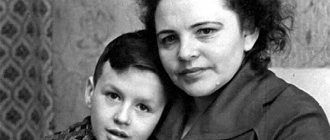Childhood and youth
The future leader of the uprising and self-proclaimed emperor Pyotr Fedorovich , was born in the village of Zimoveyskaya , which still exists in the Kotelnikovsky district of the Volgograd region. He was the fourth child in the family of Don Cossack Ivan Mikhailovich and Anna Mikhailovna Pugachev (mother's maiden name has not been established). Their ancestors had long lived in this place, and Emelyan’s surname, which thundered throughout Russia, was derived from the nickname of his grandfather, called Pugach . The official date of birth is considered to be 1742 , but it is largely controversial, since it was announced by Emelyan himself, and at different times he also named different ages; no records have been preserved in church books.
There is also no reliable information about the childhood and youth of Emelyan Pugachev. What little is known about this period of his life was told by him during interrogations and documented by Chief Secretary Stepan Ivanovich Sheshkovsky . But this evidence cannot be trusted, since Emelyan, who was a “considerable liar,” had several biographies prepared at once, as well as age options. What is certain is that he actually supported the entire household after his elder brother went into service and his sisters got married. Thus, it can be assumed that his early years were no different from the adolescence of most other Cossack children.
Interesting Facts
- Pugachev was escorted to Moscow by A.V. Suvorov. In his memoirs, Alexander Vasilyevich mentioned that the Cossack behaved with great dignity and was a good soldier who understood the intricacies of military science.
- It is known that A.S. Pushkin tried to compile a short biography of Emelyan Pugachev. He was the first to begin working on the history of the entire Peasant War.
Previous
Biographies Honore Daumier (Honore Daumier) brief biography of the artist
Next
BiographiesA short biography of Dostoevsky, the most important and interesting facts of the life of Fyodor Mikhailovich by dates for 10th grade
short biography
- 1759 - if the official date of birth is correct, then in this year 17-year-old Emelyan was enrolled in Cossack military service . In this case, only the details of this are indisputable - according to the rules established at that time, he replaced his father in the ranks, who retired after serving his due term.
- 1760 - took part in the Seven Years' War , when Russia, which had no interests in it other than increasing prestige, got involved in a purely European conflict. Young Pugachev, included in the regiment of Ilya Denisov, went to war with Prussia as part of the corps of Count Zakhary Chernyshev.
- 1762 – Emelyan Pugachev, together with his regiment returned to his homeland after the removal of Peter III. During 3 years of service in Poland and East Prussia, he remained completely unharmed, being Denisov's orderly. But he didn’t distinguish himself in anything special, except for the loss of the colonel’s horse, for which he was lashed in front of the line.
- 1763 - from this time on, he continued to serve in his native village . But over the next 4 years he was often seconded to the Polish-Lithuanian Commonwealth, as part of a detachment under the command of Captain Elisey Yakovlev . In Poland, the Don Cossacks caught runaway Old Believers, for which they regularly received incentives and promotions.
- 1769 - Emelyan, who by that time already had the Cossack officer rank of cornet (apparently, he received for “dirty work” in the Polish-Lithuanian Commonwealth) took part in the Russian-Turkish war of 1768-1774. As part of the regiment of Efim Kuteynikov, he was sent to the besieged Bendery.
- 1770 - distinguished himself during the assault on Bendery , which took place on September 16. The details of this remain unknown, but Chief General Pyotr Ivanovich Panin spoke well of him, usually stingy with praise. Apparently, the general who commanded the capture of the city himself witnessed Pugachev’s courage.
- 1771 - while staying in Elisavetgrad (modern Krapivnitsky, a city in Central Ukraine), where Russian troops were withdrawn to winter quarters, Emelyan became seriously ill . What kind of disease it was was not established, but for a long time he could not get rid of it; according to Maul, it was accompanied by rotting of the legs and chest.
- 1771 - in July he arrived in Cherkassk to ask for dismissal from service due to illness. But since the cornet Emelyan Pugachev refused to go to the infirmary for treatment, his resignation petition, considered by the military clerk Kolpakov, was rejected - he was considered a malingerer.
- 1771 - in December, having found himself under investigation for helping fugitive Cossacks, he himself was accused of desertion, got out of the prison hut and went on the run. Having crossed to the opposite “forbidden” bank of the Don, he headed to the Terek, where he arrived at the beginning of the next year.
- 1772 - in November, after long wanderings and misadventures, Pugachev arrived in Yaitsky town , where he became friends with the Old Believers, and in a conversation with Filaret, for the first time he called himself Peter III. The news of the miraculously saved sovereign quickly spread throughout the area. But False Peter did not rejoice for long; already in December he was arrested and sent to Simbirsk.
- 1773 - in May, after he was transferred from Simbirsk to Kazan for investigation, where he was sentenced to scourging and exile to Siberia , Emelyan Pugachev and Parfen Druzhinin escaped . By the beginning of autumn, he alone reached the lands of the Yaitsky Cossack army, where he again used his legend about the saved king.
- 1773 - in September, Pugachev went on a campaign with the goal of “regaining his throne,” leading a detachment of 60 people . Along the way, the “sovereign army” grew rapidly, and by the end of September he captured many Yaitsky fortresses. By October it had become so strong that it dared to besiege Orenburg.
- 1774 - in August, after the capture of many fortresses and factories, an unsuccessful attempt to capture Kazan, the rebel army was finally defeated by government troops at Black Yar . Pugachev, left with a handful of loyal comrades, decided to go down the Volga to the Caspian Sea, and from there to the lands of the Ottoman Empire.
- 1774 - in September, realizing the hopelessness of the situation, False Peter’s colonels formed a conspiracy , tied him up and handed him over to the centurion Kharchev in the Yaitsky town. After the first interrogations conducted by Savva Mavrin, he was transported to Simbirsk , and at the end of October he was sent to Moscow, where he was so eager.
- 1775 - in January, after the completion of the investigation and sentencing, Emelyan Pugachev was publicly executed on Bolotnaya Square in Moscow . Empress Catherine II showed mercy; the rebel and impostor sentenced to quartering was first cut off his head, and only then his limbs.

Execution of Emelyan Pugachev
There are a lot of “dark spots” in Pugachev’s biography; many points are still being studied by historians.
2. It is known that A.S. Pushkin tried to compile a short biography of Emelyan Pugachev. He was the first to begin working on the history of the entire Peasant War.
3. The uprising of Emelyan Pugachev, which was brutally suppressed, has gone down in history forever. It even served as the reason for the tightening of the policies of the ruling dynasty, since such a significant rebellion showed the imperial house that turmoil was brewing in society.
4. The goals of Pugachev’s uprising were quite controversial, as were some of the decisions he made, but one cannot but agree that he was a personality of impressive proportions.
5. Emelyan Pugachev was born in the village of Zimoveyskaya on the Don.
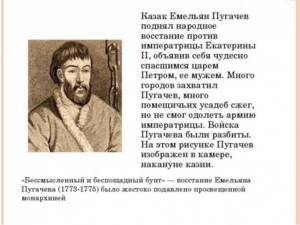
6. Pugachev’s year of birth was never precisely established. There are only approximate dates.
7. About 110 years before his birth, in the same village as him, another famous rebel was born - Stepan Razin.
8.The surname of Emelyan Pugachev comes from the nickname of his grandfather, whose name was Mikhail Pugach.
9. The family was Orthodox, his parents were tolerant of the Old Believers, but still adhered to the Nikonian rite, which was unusual for the Don Cossacks of that time.
10. Pugachev’s father was a Don Cossack. The son followed in his footsteps and enlisted in the Cossack service at the age of 17 to replace his father, who retired.
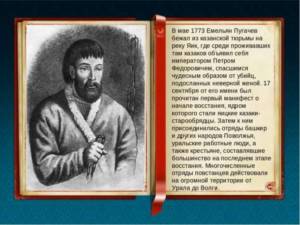
11. During his service, Emelyan Pugachev took part in the famous Seven Years' War, fighting in Prussia, as well as in the Russian-Turkish War.
12. Having become seriously ill during his service, Emelyan Pugachev asked for resignation, but was refused. He was offered treatment and return to duty. This was one of the reasons for his desire to desert from service and go on the run.
13. Pugachev did not go home, but went to Taganrog to visit his sister and brother-in-law, who at that time was preparing to escape, since neither he nor his comrades were satisfied with the conditions of service.
14. Emelyan helped organize the escape, which, in the end, failed. During interrogation, his son-in-law pointed at him as an accomplice, and Pugachev was forced to flee to the Terek, where both Don and Volga Cossacks were serving at that time.
15. He did not stay on Terek for long. On behalf of his comrades, Pugachev was supposed to go to St. Petersburg with a petition to the Military Collegium, but on the way he was detained and accused of escaping from the Don.
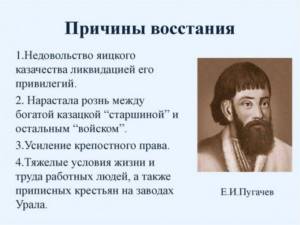
16. Pugachev, with the help of his colleagues, managed to escape, but he was caught again and fled again.
17. This time he joined the schismatics who were heading to Poland. The schismatics told him how to “legalize” himself again in the Russian Empire. Pugachev had to declare that he was an Old Believer who was returning from Poland to his homeland and wanted to live in the Orenburg province.
18. This is what Pugachev did, receiving a new passport at the border and going to settle in Mechetnaya Sloboda on the Irgiz. It was here that he became friends with the Yaik Cossacks, who were already rebelling, and for the first time called himself the name of Peter III Fedorovich, proving that he managed to escape from St. Petersburg to Tsaritsyn, and from Tsaritsyn to Yaik.
19. His conversations were reported to his superiors, and Pugachev was again arrested and sent first to Simbirsk, then to Kazan. There he was convicted, whipped and sentenced to hard labor in Siberia. But he managed to escape again and at the end of the summer of 1773 he again arrived in Yaitsky town. Pugachev spent the remaining time until the end of September 1773 preparing the uprising, hiding from the authorities.
20. In 1773, he freely took almost all the fortresses of the Yaitskaya line, and in October 1773 he led his army to Orenburg, which he put under siege.
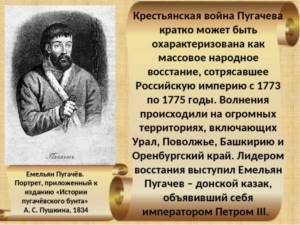
21. In March 1774, after the battle at the Tatishchev Fortress, Pugachev was forced to flee, fleeing government troops.
22. In May 1774, he managed to achieve significant successes on the Belaya River and even capture the Magnetic Fortress, but then he was again defeated by government troops and fled towards Chelyabinsk.
23. There his Cossacks united with the Bashkirs of Salavat Yulaev. Together they managed to take several cities, including Kazan. But after the victory near Kazan, the Bashkirs left, and the remnants of the Cossack-peasant army were unable to defeat the regular army under the command of I. Mekhelson. Pugachev was defeated in the battle of Black Yar, and after some time he was betrayed by his comrades and handed over to the authorities.
24. Most of the information about the Pugachev uprising remained classified for almost a century and a half
25. It was the uprising of Emelyan Pugachev that became the largest in the entire history of the Russian Empire.
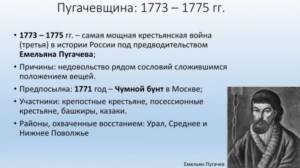
26. Attitudes towards the Pugachev uprising were very different even among the peasants. In some cities they tried to protect themselves from him, as from a robber, and asked for help from the empress, while in others they greeted him with bread and salt, as, for example, in Penza.
27. When the Pugachev uprising broke out, the Russian throne tried in every possible way to hide it from foreign powers in order to prevent them from understanding how unstable the political situation in the country was now. But rumors about this spread quickly.
28. Ataman was married twice, but only in fact, since de jure he never divorced his first wife.
29. He had two children, a daughter and a son.
30. The rebel chieftain was not an educated person, because he never received an education.
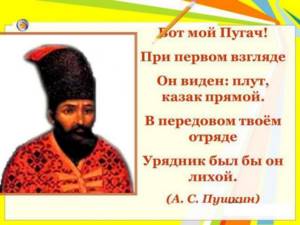
31. Pugachev partially received money for the uprising from abroad. The first assistant was the Ottoman Empire, with which Russia was then at war. Hostile France also provided assistance to the impostor’s army.
32. After the failure of the riot and the arrest of Pugachev, he was first interrogated in the Yaitsky town, then sent to Simbirsk, where he was interrogated by Chief General P. I. Panin, and after interrogations and torture he was transported to Moscow.
33. Pugachev was escorted to Moscow by A.V. Suvorov. In his memoirs, Alexander Vasilyevich mentioned that the Cossack behaved with great dignity and was a good soldier who understood the intricacies of military science.
34.The main trial began in Moscow, the progress of which was controlled by members of the Senate and Empress Catherine II herself. In December 1774, Emelyan was sentenced to death by quartering, and in January 1775 he was executed on Bolotnaya Square in Moscow.
35. As soon as the popular revolt was suppressed, and its instigator was publicly executed, Catherine II ordered the destruction of all historical evidence and surviving facts about the peasant war in order to erase the very memory of the revolt.
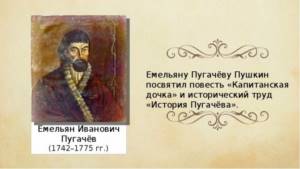
36. The tower in the Butyrka prison in Moscow served as the place of imprisonment for the rebel chieftain until his execution. It has survived to this day.
37. Legends about Pugachev’s countless treasures are still preserved. According to rumors, the treasury of the rebel chieftain contained countless treasures of the Tatar and Bashkir khans.
38. After Pugachev’s death, his family, along with his second wife, were imprisoned in a fortress, where they lived under strict surveillance for about 30 years.
39. Some historians believe that it was not Pugachev, but another person who was executed on Bolotnaya Square in Moscow, and Emelyan himself was secretly killed in Butyrka prison.
40. Immediately after Pugachev’s death, the uprising began to subside, mainly because its funding from abroad ceased.
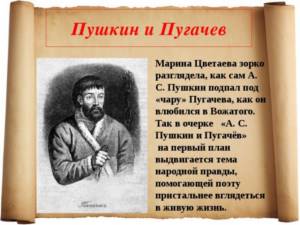
Personal life
In 1770, 18-year-old Emelyan married Sofya Dmitrievna Nedyuzheva , a native of the village of Esaulovskaya (modern Stepano-Razinsky farm in the Chernyshkovsky district of the Volgograd region). From this marriage he had three children: the eldest son Trofim , born in 1764, and two daughters, Agrafena and Christina , born in 1768 and 1770. respectively. While the self-proclaimed king was fooling and disturbing the people, his family lived in poverty, in order to somehow feed the children, Sofya Dmitrievna sold the house, and then begged for alms.
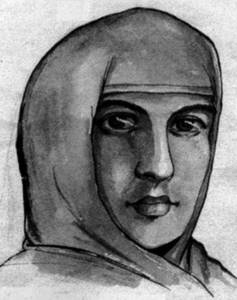
Wife Sophia
His wife and children were present at the execution of Emelyan Pugachev; they were brought to Moscow by personal order of the Empress. After that, they were sent into exile to the Kexholm (modern Priozersk, a city in the Leningrad region). Here all members of the False Peter family ended their days.
Disperse the men!
Emelyan Ivanovich himself came from Cossacks. They differed from the mass of men with whipped asses at least in that they were on the tsars' pay and were not subjected to corporal punishment. Moreover, Pugachev was a cornet - a rank corresponding to an infantry ensign or cavalry cornet. Quite an officer. And his attitude towards ordinary men was at best condescending. So, answering the investigator’s question about the number of rioters, he said: “There were as many people as I needed, only irregular people - they would become timid and run away.” What real military operations with the participation of men looked like can be judged by the battle at the Tatishcheva fortress in the spring of 1774. Seeing that defeat was inevitable, Pugachev left only the Cossacks with him during the retreat: “He ordered the remaining crowd, mostly men, to get out of here , whoever wants to go." That is, the confused “irregular people” simply abandoned him. The officers of the government troops, in their assessment of the fighting qualities of the peasants, turned out to be only a little harsher than the “people's defender”: “In the Tatishcheva case, 290 Cossacks were captured, as well as more than three thousand various rabble and bastards.”
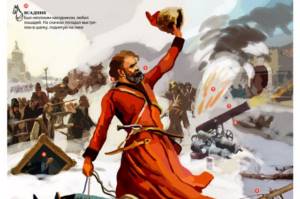
Emelyan Pugachev. Special features Read more
Pugachev’s words are well known: “I could not endure the oppression of the people; throughout Russia the peasantry and poor rabble are suffering great insults and devastation.” It is said vividly. But the records management statistics at his rate tell a different story. 46 documents of Pugachev’s Military Collegium have been preserved. However, in total it issued more than 200 manifestos and decrees. So, in his manifestos, “peasant leader” Emelyan Ivanovich addressed the peasants only twice.
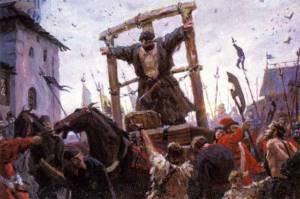
“Forgive me, Orthodox people!” How the leaders of the “Russian revolt” ended their lives Read more




